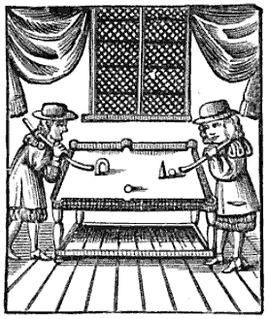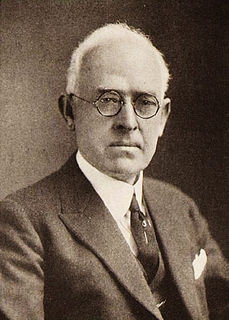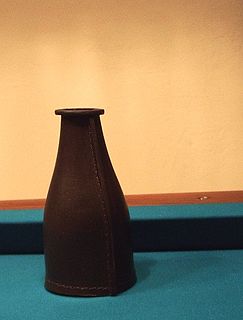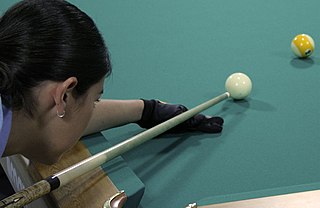Related Research Articles

Cue sports are a wide variety of games of skill played with a cue, which is used to strike billiard balls and thereby cause them to move around a cloth-covered table bounded by elastic bumpers known as cushions.

Eight-ball is a pool billiards played on a billiard table with six pockets, cue sticks, and sixteen billiard balls: a cue ball and fifteen object balls. The object balls include seven solid-colored balls numbered 1 through 7, seven striped balls numbered 9 through 15, and the black 8 ball. After the balls are scattered with a break shot, a player is assigned either the group of solid or striped balls once they have legally pocketed a ball from that group. The object of the game is to legally pocket the 8-ball in a "called" pocket, which can only be done after all of the balls from a player's assigned group have been cleared from the table.

Nine-ball is a discipline of the cue sport pool. The game's origins are traceable to the 1920s in the United States. It is played on a rectangular billiard table with pockets at each of the four corners and in the middle of each long side. Using a cue stick, players must strike the white cue ball to pocket nine colored billiard balls, hitting them in ascending numerical order. An individual game is won by the player pocketing the 9-ball. Matches are usually played as a race to a set number of racks, with the player who reaches the set number winning the match.

English billiards, called simply billiards in the United Kingdom and in many former British colonies, is a cue sport that combines the aspects of carom billiards and pool. Two cue balls and a red object ball are used. Each player or team uses a different cue ball. It is played on a billiards table with the same dimensions as one used for snooker and points are scored for cannons and pocketing the balls. English billiards has also, but less frequently, been referred to as "the English game", "the all-in game" and (formerly) "the common game".

William Joseph Mosconi was an American professional pool player from Philadelphia, Pennsylvania. Between the years of 1941 and 1957, he won the World Straight Pool Championship nineteen times. For most of the 20th century, his name was essentially synonymous with pool in North America – he was nicknamed "Mr. Pocket Billiards" – and he was among the first Billiard Congress of America Hall of Fame inductees. Mosconi pioneered and regularly employed numerous trick shots, set many records, and helped to popularize pool as a national recreation activity.

A billiard ball is a small, hard ball used in cue sports, such as carom billiards, pool, and snooker. The number, type, diameter, color, and pattern of the balls differ depending upon the specific game being played. Various particular ball properties such as hardness, friction coefficient and, resilience are important to accuracy.

Carom billiards, sometimes called carambole billiards, is the overarching title of a family of cue sports generally played on cloth-covered, pocketless billiard tables. In its simplest form, the object of the game is to score points or "counts" by caroming one's own cue ball off both the opponent's cue ball and the object ball on a single shot. The invention as well as the exact date of origin of carom billiards is somewhat obscure but is thought to be traceable to 18th-century France.

Pool is a classification of cue sports played on a table with six pockets along the rails, into which balls are deposited. Each specific pool game has its own name; some of the better-known include eight-ball, blackball, nine-ball, ten-ball, seven-ball, straight pool, one-pocket, and bank pool.
The following is a glossary of traditional English-language terms used in the three overarching cue sports disciplines: carom billiards referring to the various carom games played on a billiard table without pockets; pool, which denotes a host of games played on a table with six pockets; and snooker, played on a large pocket table, and which has a sport culture unto itself distinct from pool. There are also games such as English billiards that include aspects of multiple disciplines.

Tom Reece was an English professional player of English billiards. He was six times runner-up in the professional billiards championship, now regarded as the world championship, losing three times to Melbourne Inman in finals from 1912 to 1914, and three times to Tom Newman in the 1921, 1924 and 1925 finals. He made the unofficial world's highest billiards break of 499,135 in 1907 using a cradle cannon technique shortly before it was banned from the sport. In 1927, his prowess with the pendulum stroke led to that also being banned from use in competition.

Five-pin billiards or simply five-pins or 5-pins, is today usually a carom billiards form of cue sport, though sometimes still played on a pocket table. In addition to the customary three balls of most carom games, it makes use of a set of five upright pins (skittles) arranged in a "+" pattern at the center of the table. The game is popular especially in Italy and Argentina, but also in some other parts of Latin America and Europe, with international, televised professional tournaments. It is sometimes referred to as Italian five-pins or Italian billiards, or as italiana. A variant of the game, goriziana or nine-pins, adds additional skittles to the formation. A related pocket game, with larger pins, is played in Scandinavia and is referred to in English as Danish pin billiards, with a Swedish variant that has some rules more similar to the Italian game.

A trick shot is a shot played on a billiards table, which seems unlikely or impossible or requires significant skill. Trick shots frequently involve the balls organized in ways that are unlikely or impossible to appear in normal play, such as balls being in a straight line, or use props such as extra cues or a triangle that would not be allowed on the table during a game. As an organized cue sports discipline, trick shot competition is known as artistic pool.

William Alexander Spinks Jr. was an American professional player of carom billiards in the late 19th and early 20th centuries. He was often referred to as W. A. Spinks, and occasionally Billy Spinks. In addition to being amateur Pacific Coast Billiards Champion several times, a world-champion contender in more than one cue sports discipline, and an exhibition player in Europe, he became the co-inventor of modern billiard cue chalk in 1897.

Bottle pool, also known as bottle-billiards and bottle pocket billiards, is a hybrid billiards game combining aspects of both carom billiards and pocket billiards. Played on a standard pool table, the game uses just two object balls, a cue ball, and a 6¾ inch (171 mm) tall, narrow-necked bottle called a shake bottle or tally bottle, traditionally made from leather, that is placed on the table and used as a target for caroms. Those unfamiliar with the game sometimes mistakenly use its name as a synonym for the very different game of kelly pool. Bottle pool has been described as combining "elements of billiards, straight pool and chess under a set of rules that lavishly rewards strategic shot making and punishes mistakes with Sisyphean point reversals."
The World Billiards Championship is an international cue sports tournament in the discipline of English billiards, organised by World Billiards, a subsidiary of the World Professional Billiards and Snooker Association (WPBSA). In its various forms, and usually as a single competition, the title is one of the oldest sporting world championships, having been contested since 1870.
Carom billiards and pool are two types of cue sports or billiards-family games, which as a general class are played with a stick called a cue which is used to strike billiard balls, moving them around a cloth-covered billiard table bounded by rubber cushions attached to the confining rails of the table.

Frank B. Adams, commonly known as Yank Adams, was a professional carom billiards player who specialized in finger billiards, in which a player directly manipulates the balls with his or her hands, instead of using an implement such as a cue stick, often by twisting the ball between one's thumb and middle finger. Adams, who was sometimes billed as the "Digital Billiard Wonder", has been called the "greatest of all digit billiards players", and the "champion digital billiardist of the World." George F. Slosson, a top billiards player of Adams' era, named him the "greatest exhibition player who ever lived." Adams' exhibitions drew audiences of 1,000 or more, leaving standing room only, even in small venues.

A cue stick is an item of sporting equipment essential to the games of pool, snooker and carom billiards. It is used to strike a ball, usually the cue ball. Cues are tapered sticks, typically about 57–59 inches long and usually between 16 and 21 ounces (450–600 g), with professionals gravitating toward a 19-ounce (540 g) average. Cues for carom tend toward the shorter range, though cue length is primarily a factor of player height and arm length. Most cues are made of wood, but occasionally the wood is covered or bonded with other materials including graphite, carbon fiber or fiberglass. An obsolete term for a cue, used from the 16th to early 19th centuries, is billiard stick.
John Roberts Sr. was a Welsh champion player of English billiards.

Edwin Kentfield, also known as Jonathan Kentfield, was an English player of English billiards. He claimed the Billiards Championship in 1825 and held it uncontested until 1849.
References
- 1 2 3 4 Everton, Clive (2012). A History of Billiards. englishbilliards.org. pp. 18–24. ISBN 978-0-9564054-5-6.
- 1 2 Sydenham Dixon (29 March 2011) [1896]. History of Billiards. Read Books Limited. pp. 3–. ISBN 978-1-4465-4859-2.
- ↑ Bennett, Joseph (1899). Billiards.